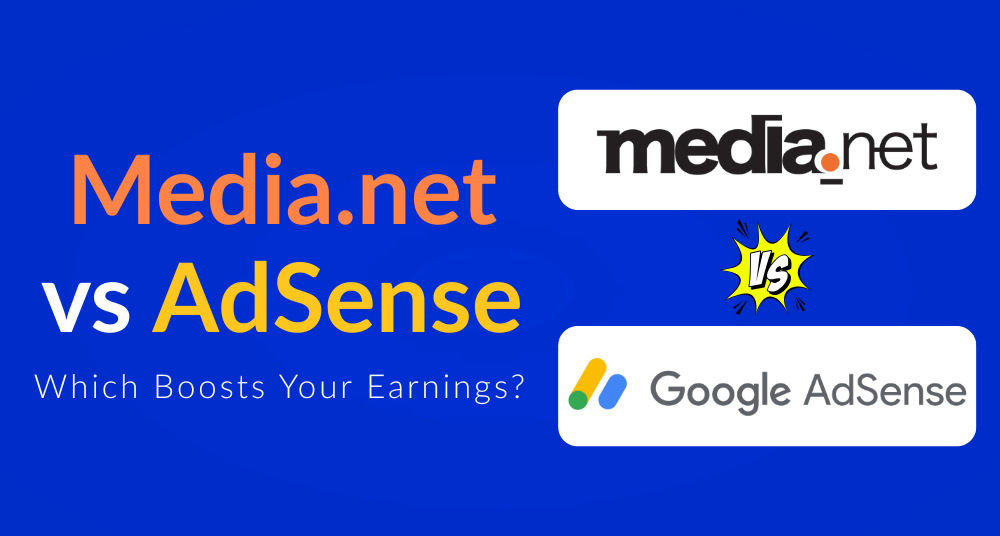In 2025, digital advertising continues to evolve rapidly. With the cookieless era, AI-driven contextual ads, and diversified demand sources, publishers must carefully choose ad networks that align with their goals. Among all available options, Google AdSense and Media.net remain two of the most dominant forces.
Both promise strong monetization and easy integration, but when it comes to actual revenue performance, which platform truly delivers more value?
This detailed Media.net vs AdSense comparison explores how each works, where they excel, and what kind of publishers benefit most from them. By the end, you’ll have a clear understanding of whether AdSense or Media.net is better suited to your monetization strategy in 2025.
AdSense at a Glance
Google AdSense has been the default monetization platform for publishers for nearly two decades. It gives website owners access to Google’s enormous advertiser pool through automated auctions that determine the best ad to show in every impression.
Key Features
- Access to Google Ads, Display & Video 360, and programmatic demand.
- CPC (Cost Per Click) and CPM (Cost Per Mille) bidding models.
- Auto Ads feature for simple, automated placements.
- Integration with Google Analytics and Search Console.
- Consistent payouts and transparent reporting.
Advantages
- Global advertiser coverage — unmatched in scale.
- Reliable payments with strong anti-fraud systems.
- Easy setup for beginners with clear policies.
- Optimized ad matching using Google’s machine learning.
Drawbacks
- High competition means lower RPMs in general niches.
- Strict policy enforcement can cause sudden ad restrictions.
- Limited manual optimization opportunities for small publishers.
In short, AdSense remains the most stable and beginner-friendly choice for most content publishers, especially those with global traffic.
Media.net at a Glance
Media.net—powered by the Yahoo! Bing network—focuses heavily on contextual advertising. Unlike AdSense’s audience-based targeting, Media.net emphasizes relevance to on-page content, aligning ads closely with user intent.
Key Features
- Strong contextual and native ad units.
- Premium advertiser partnerships, especially in finance, tech, and business niches.
- Personalized support and optimization for mid-size and large publishers.
- Responsive ad formats and custom styling for improved integration.
Advantages
- Higher CTR (Click-Through Rate) on contextually rich content.
- Excellent support for English-language markets (US, UK, Canada).
- Revenue consistency in business-related verticals.
- Dedicated account managers for performance optimization.
Drawbacks
- Narrower demand pool compared to Google.
- Stricter site approval process.
- Slower reporting and payout cycles than AdSense.
In essence, Media.net rewards quality, content-heavy sites and performs best in high-intent niches like finance, investing, law, or enterprise software.
Understanding the Metrics: CPC, CPM, and RPM
To evaluate ad networks correctly, you must know what the main revenue metrics mean:
- CPC (Cost Per Click): The amount paid when a user clicks an ad.
- CPM (Cost Per Mille): The amount paid per 1,000 ad impressions.
- RPM (Revenue Per Mille): Publisher’s revenue per 1,000 pageviews — the best metric for comparing networks.
RPM is what ultimately determines your monetization efficiency. It varies based on geography, niche, and traffic engagement.
Reach, Scale & Advertiser Pool
One of the major differentiators is the depth and breadth of demand-side advertisers.
- AdSense benefits from Google’s enormous advertiser ecosystem, including many small, medium, and enterprise advertisers globally. This ensures broad demand, especially for general or niche sites, across many geographies.
- Media.net, powered by Yahoo! and Bing ad demand, tends to focus more on contextual campaigns and for certain regions (like U.S., U.K.). Its advertiser pool is narrower than Google’s but can be strong in specific verticals (finance, business, technology) where context-based ads command higher payouts.
In market share terms, AdSense still dominates the ad serving space, with one report citing ~70-plus percent share, whereas Media.net holds a relatively small fraction (~4-5%) in ad serving comparisons.
That scale gives AdSense an edge in fill rate (i.e. fewer empty ad slots) and geographic coverage.
Revenue Models, Share & eCPM / RPM
Revenue Share & Payouts
- With AdSense, publishers typically keep ~68% of ad revenue, while Google retains ~32%.
- Media.net’s revenue share (the publisher’s cut) is less transparently published and varies depending on niche, traffic quality, and region. Some sources estimate Media.net’s payout ranges / effective CPMs in the $1.00–$1.25 zone in U.S. contexts under favorable conditions.
eCPM / RPM Comparisons
- In certain niches and for U.S./U.K. traffic, Media.net can outperform AdSense in RPM when content is well-matched and ad placements are optimized.
- AdSense still tends to win on volume and consistency across general traffic, especially for lower-tier geographies, because of its broader advertiser pool.
- Some sources note that AdSense performs better in “product-light” content niches (e.g. general blogs) whereas Media.net excels in “product-heavy” or content-rich pages with strong contextual signals.
Thus, the revenue per 1,000 impressions (RPM) or effective cost per mille (eCPM) can swing depending on content type, traffic geography, placement, and optimization.
Niche & Traffic Fit
Choosing which network works better often depends heavily on the kind of site you run and where your audience is located.
- English, U.S./U.K. traffic: Media.net tends to shine when your traffic is from Tier-1 countries and content has strong topical alignment (finance, tech, business). In those cases, RPMs can be strong.
- Mixed / global traffic: AdSense has the advantage in filling ads across varied geographies. Even parts of your traffic from lower-tier regions may get monetized, albeit at lower rates.
- Content-heavy / text blogs: Media.net is optimized for contextual matching, which works well in pages with rich text.
- Visual / multimedia sites: AdSense’s flexibility in ad formats (display, video, etc.) may offer more options.
- Smaller / niche sites: For smaller sites, AdSense might be easier to start with due to simpler setup and broader reach.
In many real-world publisher reports, Media.net is often cited as the “second best alternative” to AdSense for contexts where AdSense’s returns are limited.
Placement, Format & Ad Types
How and where ads are placed, and what ad types are supported, is crucial.
- AdSense supports a wide variety: display banners, responsive ads, matched content, native ads, in-article, video, link units, etc.
- Media.net focuses more on contextual / native / text-based ad units that blend with content. It’s strong in placements within or beside text, or sticky sidebars where contextual relevancy is high.
- AdSense often performs better above the fold or in standard banner slots, thanks to its wide advertiser inventory. Media.net may outperform in placements deeper in content or sidebar sticky units.
- The difference in ad format capabilities can influence how much revenue gap there is in practice, especially in more visual or product-driven sites.
Approval, Policies & Stability
These are very important for long-term monetization.
- AdSense is known for strict policies, and accounts may be suspended for violations—publishers must adhere closely to content guidelines, click policies, etc.
- Media.net also has approval criteria (quality content, niche, traffic levels) and stricter contextual alignment requirements. Some publishers find Media.net’s approval process more selective.
- Because AdSense is more ubiquitous, many publishers find it more stable and well-supported in many edge cases.
- On the flip side, AdSense’s strictness sometimes causes bans or issues for publishers who don’t follow evolving policies.
Stability and account safety matter more than marginal revenue gains — a suspended account kills revenue.
Reporting, Tools & Optimization Features
How much insight and control you get matters greatly.
- AdSense offers robust analytics, performance breakdowns, experiments, ad unit controls, and integration with Google products (Analytics, Tag Manager). This ecosystem advantage helps many publishers refine yield.
- Media.net also provides publisher dashboards, reporting, and optimization aids. Some users report it offers more contextual reporting and deeper insights into ad performance per content segment.
- However, AdSense’s ecosystem integrations often give it an edge in holistic optimization (tracking user behavior & conversion funnels).
Strengths, Weaknesses & Risks
Here’s a comparative SWOT-style outlook:
| Platform | Strengths | Weaknesses / Risks |
| AdSense | Huge advertiser pool, broad fill rate, flexible ad formats, ecosystem integration | Strict policies, account suspensions, lower RPM in some niches |
| Media.net | Strong contextual relevance, competitive RPMs in specific niches, good alternative when AdSense underperforms | Smaller advertiser base, limited reach in non-Tier-1 geos, selective approval |
Also, many publishers use both networks together (AdSense + Media.net) to hedge risk and squeeze additional revenue from slots AdSense couldn’t fill well.
Case Scenarios: Which Works Best Where
- High-volume U.S./U.K. traffic, text-rich content (e.g. tech, finance blogs) — Media.net might compete or surpass AdSense in RPM.
- Mixed geographies, broad content sites — AdSense likely gives steadier baseline revenue.
- New or small blogs — Start with AdSense for easier setup, then layer Media.net or test side-by-side.
- Sites with many pageviews that AdSense can’t fully fill — Use Media.net as backup to monetize unfilled inventory.
Strategy for 2025: Combining / Testing
A smart revenue strategy in 2025 is less about choosing one winner and more about testing, combining, and optimizing:
- Use both networks (AdSense + Media.net), letting each fill what the other doesn’t.
- A/B test ad placements, formats, and proportions to see which configuration yields better total revenue.
- Segment traffic by geography or content type — direct high-value traffic to the network that pays better.
- Monitor RPM trends month to month — revenue sources shift over time, especially as advertiser demand changes.
- Stay updated on both networks’ policies, features, and ad tech shifts — leverage new ad format support, header bidding, etc.
Predictions & Future Trends
Looking forward to how this battle might evolve:
- Contextual and privacy-based ads will grow in importance as user tracking becomes more restricted — this could benefit Media.net, which is built around context rather than behavioral retargeting.
- Programmatic demand and header bidding will push both networks (and publisher yield partners) to adapt.
- Ad networks may further segment by niche, offering specialized vertical ad pools (e.g. finance, education) to extract higher revenue.
- Ad platform ecosystems (like Google’s with Analytics, Ads, AdSense) may further deepen integration, raising the barrier for alternatives.
- Publishers may increasingly rely on diversified monetization (ads + subscriptions + affiliate + sponsorship) to reduce dependence on any one network.
Final Verdict: Media.net vs AdSense
There’s no one-size-fits-all winner in Media.net vs AdSense — it depends largely on traffic source, niche, placement, and optimization.
So — who wins the 2025 revenue battle between Media.net and AdSense?
There’s no absolute winner. Each excels under different conditions:
- AdSense dominates in fill rate, global coverage, and reliability.
- Media.net wins in contextual accuracy, account support, and niche-specific performance.
The smartest move is a hybrid approach that leverages both — using AdSense as the foundation and Media.net as the performance booster for contextual relevance.
In 2025, success in monetization isn’t about choosing one network over another; it’s about combining, testing, and optimizing continuously. That’s how you win the real revenue battle.
FAQs
Q1. Can I use both AdSense and Media.net on the same page?
Yes, but not in overlapping ad slots. Each must serve distinct placements.
Q2. Which pays more — AdSense or Media.net?
Depends on your niche. AdSense generally pays more for broad traffic; Media.net can outperform it in finance, legal, and enterprise content.
Q3. What’s the minimum payout for both?
Both have a $100 minimum threshold.
Q4. Are Media.net ads better for SEO?
Neither directly impacts SEO, but cleaner layouts and better UX improve user engagement, indirectly benefiting rankings.
Q5. Does Media.net support mobile apps?
It primarily focuses on websites, whereas Google offers AdMob for app monetization.
Q6. How can I boost RPM quickly?
Improve ad viewability, test placement variations, and target Tier 1 geographies.
Related Blog: ChatGPT vs Google Gemini






What do you think?
It is nice to know your opinion. Leave a comment.